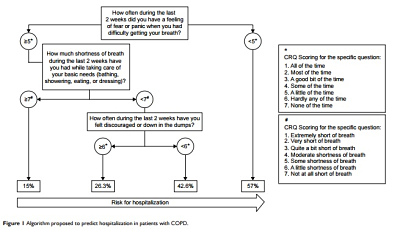Article
3 COPD Symptoms That Could Predict Hospitalization
Author(s):
For patients with chronic obstructive pulmonary disease (COPD), fear during episodes of breathlessness, dyspnea during typical daily activities, and depressive symptoms may be good predictors of hospitalization.
For patients with chronic obstructive pulmonary disease (COPD), fear during episodes of breathlessness, dyspnea during typical daily activities, and depressive symptoms may be good predictors of hospitalization.
A new study published in The International Journal of COPD has determined that these patient-reported symptoms are important forecasters to look for.
Health care providers are in need of simple tools to stratify COPD patients’ hospitalization risk, especially in light of the high economic and social costs surrounding hospitalization, the researchers noted.
Logistics can prevent providers from using questionnaires on a daily basis, but individual questions from useful ones can be informative and predictive, the study authors claimed.
“Our findings extend previous reports suggesting that individual items within questionnaires can be as sensitive, if not more sensitive, than the overall scores and content of larger questionnaires to forecast specific outcomes,” the researchers stated.
They sought to determine whether individual questions from the Chronic Respiratory Questionnaire Self-Assessment Survey could be predictive of hospitalization, and then they attempted to develop a simple algorithm to use in routine practice.
The researchers examined more than 490 patients with COPD, collected demographic information, and conducted pulmonary function testing. The group’s mean age was 70, and 54% were men.
The authors found that 20% of the study group felt fear or panic when experiencing shortness of breath most or all of the time. These patients had a 57% greater risk of hospitalization compared with the 27% risk for the rest of the sample.
Another 20% of the group felt at least mildly short of breath while taking care of basic needs and also “felt discouraged or down in the dumps” at least some of the time. These patients saw a 43% greater risk of hospitalization.
The researchers created the following algorithm as an aid for health care providers:

(Forecasting COPD Hospitalization in the Clinic: Optimizing the Chronic Respiratory Questionnaire)
“We support and extend previous reports about the impact emotions (anxiety and depression) have on health care utilization (in addition to physical functioning and quality of life),” the researchers concluded.
They warned that their algorithm could lead to false positives and negatives, so it should not considered a diagnostic laboratory test. Rather, providers can use it as a supplementary source of information.
COPD is expected to become the third-leading cause of death by 2020, the researchers noted.





